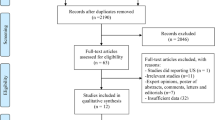Abstract
Introduction
The reliable diagnosis of partial-thickness tears of the rotator cuff is still elusive in clinical practise. Therefore, the purpose of the study was to determine the diagnostic accuracy of MR imaging and clinical tests for detecting partial-thickness tears of the rotator cuff as well as the combination of these parameters.
Materials and methods
334 consecutive shoulder arthroscopies for rotator cuff pathologies performed during the time period between 2010 and 2012 were analyzed retrospectively for the findings of common clinical signs for rotator cuff lesions and preoperative MR imaging. These were compared with the intraoperative arthroscopic findings as “gold standard”. The reports of the MR imaging were evaluated with regard to the integrity of the rotator cuff. The Ellman Classification was used to define partial-thickness tears of the rotator cuff in accordance with the arthroscopic findings. Descriptive statistics, sensitivity, specificity, positive and negative predictive value were calculated.
Results
MR imaging showed 80 partial-thickness and 70 full-thickness tears of the rotator cuff. The arthroscopic examination confirmed 64 partial-thickness tears of which 52 needed debridement or refixation of the rotator cuff. Sensitivity for MR imaging to identify partial-thickness tears was 51.6%, specificity 77.2%, positive predictive value 41.3% and negative predictive value 83.7%. For the Jobe-test, sensitivity was 64.1%, specificity 43.2%, positive predictive value 25.9% and negative predictive value 79.5%. Sensitivity for the Impingement-sign was 76.7%, specificity 46.6%, positive predictive value 30.8% and negative predictive value 86.5%. For the combination of MR imaging, Jobe-test and Impingement-sign sensitivity was 46.9%, specificity 85.4%, positive predictive value 50% and negative predictive value 83.8%.
Conclusions
The diagnostic accuracy of MR imaging and clinical tests (Jobe-test and Impingement-sign) alone is limited for detecting partial-thickness tears of the rotator cuff. Additionally, the combination of MR imaging and clinical tests does not improve diagnostic accuracy.
Level of evidence
Level II, Diagnostic study.


Similar content being viewed by others
References
Matthewson G, Beach CJ, Nelson AA, Woodmass JM, Ono Y, Boorman RS, Lo IK, Thornton GM (2015) Partial thickness rotator cuff tears: current concepts. Adv Orthop 2015:458786
Sher JS, Uribe JW, Posada A, Murphy BJ, Zlatkin MB (1995) Abnormal findings on magnetic resonance images of asymptomatic shoulders. J Bone Joint Surg Am 77:10–15
Grant JA, Miller BS, Jacobson JA, Morag Y, Bedi A, Carpenter JE (2013) Intra- and inter-rater reliability of the detection of tears of the supraspinatus central tendon on MRI by shoulder surgeons. J Shoulder Elbow Surg 22:725–731
Roy JS, Braen C, Leblond J, Desmeules F, Dionne CE, MacDermid JC, Bureau NJ, Fremont P (2015) Diagnostic accuracy of ultrasonography, MRI and MR arthrography in the characterisation of rotator cuff disorders: a systematic review and meta-analysis. Br J Sports Med 49:1316–1328
Balich SM, Sheley RC, Brown TR, Sauser DD, Quinn SF (1997) MR imaging of the rotator cuff tendon: interobserver agreement and analysis of interpretive errors. Radiology 204:191–194
Jain NB, Luz J, Higgins LD, Dong Y, Warner JJ, Matzkin E, Katz JN (2017) The diagnostic accuracy of special tests for rotator cuff tear: the ROW cohort study. Am J Phys Med Rehabil 96:176–183
Lenza M, Buchbinder R, Takwoingi Y, Johnston RV, Hanchard NC, Faloppa F (2013) Magnetic resonance imaging, magnetic resonance arthrography and ultrasonography for assessing rotator cuff tears in people with shoulder pain for whom surgery is being considered. Cochrane Database Syst Rev 9:CD009020
Ellman H (1990) Diagnosis and treatment of incomplete rotator cuff tears. Clin Orthop Relat Res 254:64–74
Halma JJ, Eshuis R, Krebbers YM, Weits T, de Gast A (2012) Interdisciplinary inter-observer agreement and accuracy of MR imaging of the shoulder with arthroscopic correlation. Arch Orthop Trauma Surg 132:311–320
Neer CS (1983) Impingement lesions. Clin Orthop Relat Res 173:70–77
Dinnes J, Loveman E, McIntyre L, Waugh N (2003) The effectiveness of diagnostic tests for the assessment of shoulder pain due to soft tissue disorders: a systematic review. Health Technol Assess 7:iii, 1–iii166
Kelly SM, Brittle N, Allen GM (2010) The value of physical tests for subacromial impingement syndrome: a study of diagnostic accuracy. Clin Rehabil 24:149–158
Villafane JH, Valdes K, Anselmi F, Pirali C, Negrini S (2015) The diagnostic accuracy of five tests for diagnosing partial-thickness tears of the supraspinatus tendon: a cohort study. J Hand Ther 28:247–251
Park HB, Yokota A, Gill HS, El Rassi G, McFarland EG (2005) Diagnostic accuracy of clinical tests for the different degrees of subacromial impingement syndrome. J Bone Joint Surg Am 87:1446–1455
Author information
Authors and Affiliations
Corresponding author
Ethics declarations
Conflict of interest
The manuscript has been read and approved by all authors. The authors believe that this manuscript represents honest work. The authors report no conflict of interest.
Funding
There is no funding source.
Ethical approval
As this is a retrospective analysis of medical and radiological data files no ethical approval was obtained. Approval was given by the Institutional Research Coordinator and the head of the Department of Orthopaedics and Orthopaedic Surgery, Saarland University Medical Center, in January 2013.
Informed consent
As this is a retrospective analysis of medical and radiological data files no informed consent was signed from the patients. Patient data were anonymized.
Rights and permissions
About this article
Cite this article
Brockmeyer, M., Schmitt, C., Haupert, A. et al. Limited diagnostic accuracy of magnetic resonance imaging and clinical tests for detecting partial-thickness tears of the rotator cuff. Arch Orthop Trauma Surg 137, 1719–1724 (2017). https://doi.org/10.1007/s00402-017-2799-3
Received:
Published:
Issue Date:
DOI: https://doi.org/10.1007/s00402-017-2799-3




